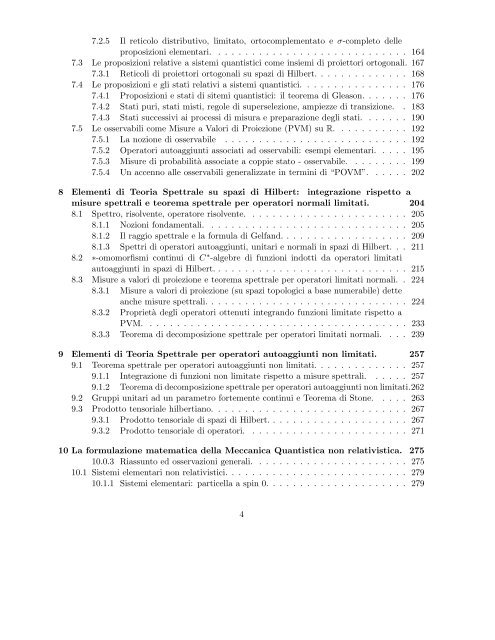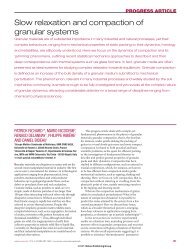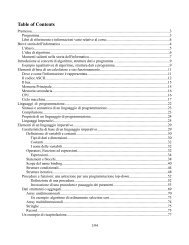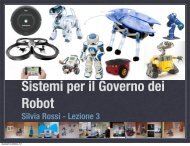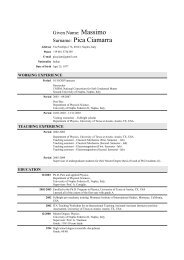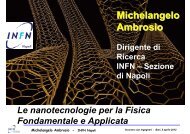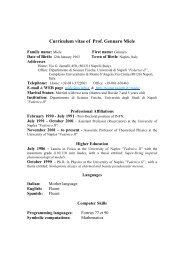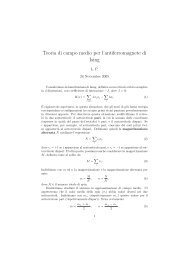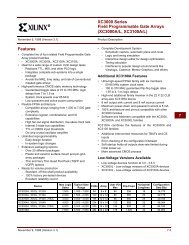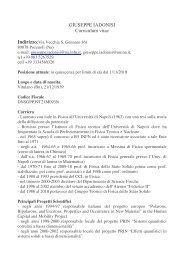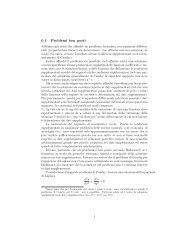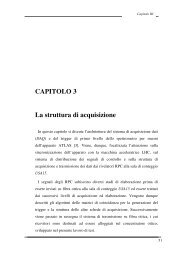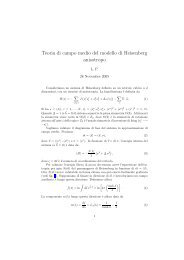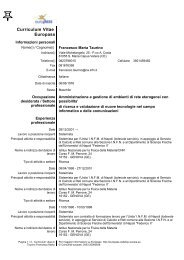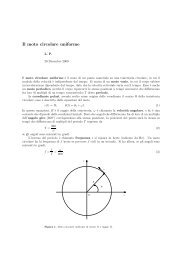Teoria Spettrale in Spazi di Hilbert e Struttura Matematica delle ... - Infn
Teoria Spettrale in Spazi di Hilbert e Struttura Matematica delle ... - Infn
Teoria Spettrale in Spazi di Hilbert e Struttura Matematica delle ... - Infn
Create successful ePaper yourself
Turn your PDF publications into a flip-book with our unique Google optimized e-Paper software.
7.2.5 Il reticolo <strong>di</strong>stributivo, limitato, ortocomplementato e σ-completo <strong>delle</strong><br />
proposizioni elementari. . . . . . . . . . . . . . . . . . . . . . . . . . . . . 164<br />
7.3 Le proposizioni relative a sistemi quantistici come <strong>in</strong>siemi <strong>di</strong> proiettori ortogonali. 167<br />
7.3.1 Reticoli <strong>di</strong> proiettori ortogonali su spazi <strong>di</strong> <strong>Hilbert</strong>. . . . . . . . . . . . . . 168<br />
7.4 Le proposizioni e gli stati relativi a sistemi quantistici. . . . . . . . . . . . . . . . 176<br />
7.4.1 Proposizioni e stati <strong>di</strong> sitemi quantistici: il teorema <strong>di</strong> Gleason. . . . . . . 176<br />
7.4.2 Stati puri, stati misti, regole <strong>di</strong> superselezione, ampiezze <strong>di</strong> transizione. . 183<br />
7.4.3 Stati successivi ai processi <strong>di</strong> misura e preparazione degli stati. . . . . . . 190<br />
7.5 Le osservabili come Misure a Valori <strong>di</strong> Proiezione (PVM) su R. . . . . . . . . . . 192<br />
7.5.1 La nozione <strong>di</strong> osservabile . . . . . . . . . . . . . . . . . . . . . . . . . . . 192<br />
7.5.2 Operatori autoaggiunti associati ad osservabili: esempi elementari. . . . . 195<br />
7.5.3 Misure <strong>di</strong> probabilità associate a coppie stato - osservabile. . . . . . . . . 199<br />
7.5.4 Un accenno alle osservabili generalizzate <strong>in</strong> term<strong>in</strong>i <strong>di</strong> “POVM”. . . . . . 202<br />
8 Elementi <strong>di</strong> <strong>Teoria</strong> <strong>Spettrale</strong> su spazi <strong>di</strong> <strong>Hilbert</strong>: <strong>in</strong>tegrazione rispetto a<br />
misure spettrali e teorema spettrale per operatori normali limitati. 204<br />
8.1 Spettro, risolvente, operatore risolvente. . . . . . . . . . . . . . . . . . . . . . . . 205<br />
8.1.1 Nozioni fondamentali. . . . . . . . . . . . . . . . . . . . . . . . . . . . . . 205<br />
8.1.2 Il raggio spettrale e la formula <strong>di</strong> Gelfand. . . . . . . . . . . . . . . . . . . 209<br />
8.1.3 Spettri <strong>di</strong> operatori autoaggiunti, unitari e normali <strong>in</strong> spazi <strong>di</strong> <strong>Hilbert</strong>. . . 211<br />
8.2 ∗-omomorfismi cont<strong>in</strong>ui <strong>di</strong> C ∗ -algebre <strong>di</strong> funzioni <strong>in</strong>dotti da operatori limitati<br />
autoaggiunti <strong>in</strong> spazi <strong>di</strong> <strong>Hilbert</strong>. . . . . . . . . . . . . . . . . . . . . . . . . . . . . 215<br />
8.3 Misure a valori <strong>di</strong> proiezione e teorema spettrale per operatori limitati normali. . 224<br />
8.3.1 Misure a valori <strong>di</strong> proiezione (su spazi topologici a base numerabile) dette<br />
anche misure spettrali. . . . . . . . . . . . . . . . . . . . . . . . . . . . . . 224<br />
8.3.2 Proprietà degli operatori ottenuti <strong>in</strong>tegrando funzioni limitate rispetto a<br />
PVM. . . . . . . . . . . . . . . . . . . . . . . . . . . . . . . . . . . . . . . 233<br />
8.3.3 Teorema <strong>di</strong> decomposizione spettrale per operatori limitati normali. . . . 239<br />
9 Elementi <strong>di</strong> <strong>Teoria</strong> <strong>Spettrale</strong> per operatori autoaggiunti non limitati. 257<br />
9.1 Teorema spettrale per operatori autoaggiunti non limitati. . . . . . . . . . . . . . 257<br />
9.1.1 Integrazione <strong>di</strong> funzioni non limitate rispetto a misure spettrali. . . . . . 257<br />
9.1.2 Teorema <strong>di</strong> decomposizione spettrale per operatori autoaggiunti non limitati.262<br />
9.2 Gruppi unitari ad un parametro fortemente cont<strong>in</strong>ui e Teorema <strong>di</strong> Stone. . . . . 263<br />
9.3 Prodotto tensoriale hilbertiano. . . . . . . . . . . . . . . . . . . . . . . . . . . . . 267<br />
9.3.1 Prodotto tensoriale <strong>di</strong> spazi <strong>di</strong> <strong>Hilbert</strong>. . . . . . . . . . . . . . . . . . . . . 267<br />
9.3.2 Prodotto tensoriale <strong>di</strong> operatori. . . . . . . . . . . . . . . . . . . . . . . . 271<br />
10 La formulazione matematica della Meccanica Quantistica non relativistica. 275<br />
10.0.3 Riassunto ed osservazioni generali. . . . . . . . . . . . . . . . . . . . . . . 275<br />
10.1 Sistemi elementari non relativistici. . . . . . . . . . . . . . . . . . . . . . . . . . . 279<br />
10.1.1 Sistemi elementari: particella a sp<strong>in</strong> 0. . . . . . . . . . . . . . . . . . . . . 279<br />
4


